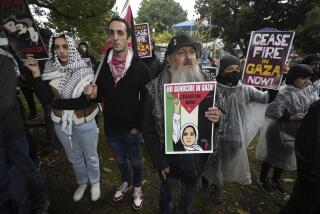Cooperative, Collective Farms Drop All-for-One Values : Down on the Kibbutz, Israelis Face a Financial Crisis
AVIEL, Israel — Yaacov Mishulan, who grows roses and grapes on a cooperative farm in north-central Israel, staggered toward the Mediterranean Sea near Caesarea in the hope that the tide and a handful of Valium he had swallowed would end the agony of heavy debt and humiliation.
He never made it to the water. The overdose of Valium brought him down on the sandy beach, and passers-by got him to a hospital.
But no such rescue is in sight for his debt, which totals about $300,000. Shunned by his neighbors and pursued by banks, Mishulan is in a downward spiral that threatens a livelihood he once held dear.
‘Left Out on a Limb’
“There was a time when everyone pulled together,” Mishulan, 43, said with a sigh recently in an interview at the home of watchful relatives. “Now it is every man for himself. And I was left out on a limb. I could not take it any more.”
Israel’s system of cooperative and collective farms-- moshavim and kibbutzim --is threatened by a financial crisis swamping them with debt. At the same time, the socialist, all-for-one values that were the underpinnings of community life are fading rapidly in a society turning sharply to the right.
The implications of the two fundamental changes in the farm landscape go beyond questions of planting and harvesting, however. The kibbutzim and moshavim had come to be identified with something basic in the Israeli character, a selfless pioneering spirit that had helped forge the nation.
Their existence had been viewed as important to Israel’s self-image, much in the way the family farm is in the United States, the ejido cooperative in Mexico, the commune in Maoist China.
But the kibbutz and the moshav are facing a severe restructuring in order to survive. Utopian aspects of sharing and sacrificing are being replaced by individual decision-making and arrangements that encourage members to go it alone.
“This is Israel’s perestroika ,” observed Zeev Shabtai, referring to Soviet President Mikhail S. Gorbachev’s program of political and economic restructuring. Shabtai, a longtime resident of the pioneering kibbutz of Beit Oren, near Haifa, added that “we are changing with the times.”
Yaron Ezrahi, a political theorist at Hebrew University, said: “The communal and cooperative styles of farming were based on persons who made extraordinary sacrifices for an ideal of nationhood. Their decline is an aspect of the country’s ideological crisis, a lost sense of mission.”
Although only 4% of all Israelis live on kibbutzim or moshavim , they contribute more than twice that percentage to the nation’s production. As emblems of the Jewish state, the farms have provided soldiers and civic leaders beyond their proportion of the population.
Now, reports of strain on the farm are almost daily fare in Israeli newspapers. Not long ago, members of a cooperative in the north, angered that a bank had attached their income in order to collect on a debt, brought a cow into the local branch office and challenged the banker to take care of the animal himself.
As economic conditions have worsened, members of moshavim and kibbutzim are fleeing to the city, leaving their debts behind.
Sometimes they have tried to flee life itself. Mishulan’s suicide attempt in February was the second in Aviel. The first, by an Auschwitz survivor and veteran of four Arab-Israeli wars, succeeded; the man hanged himself from a tree in his back yard. Like Mishulan, he had fallen in debt and felt that he had no prospect of getting out from under it. A member of a moshav near the Arab town of Tulkarm also killed himself.
The debt crisis started in 1984, when the Israeli government began to make sharp changes in economic policy in order to curb inflation, which had reached 1,000% a year. Among the changes were sharp and sudden increases in interest rates.
Billions Owed
Meanwhile, overall debt has worsened. The 280 kibbutzim owe about $4.25 billion and the 420 moshavim about $1.5 billion, the government estimates. In both cases, the total debt is twice as high as in 1985.
The government and farm associations are now locked in tough negotiations on how to pay off--or not pay off--the debt. Farmers want the banks to cancel part of the debt, while the banks are asking the government to pick up their losses. The government, for its part, is urging members of the kibbutzim and moshavim to recover their solvency by altering a way of life built up over decades.
The moshavim operate in loose federations that supply money for planting and provide marketing services after the harvest. Members took out debts individually, but the cooperative as a whole guaranteed repayment. But when Mishulan and other farmers fell into debt, associates who were better off balked at bailing him out.
Mishulan, a rangy former dockworker who has farmed at Aviel for 10 years, complained: “I can’t get a loan now. No one will give one to me. I can’t plant without money.”
His slide into debt began with a loan to buy a tractor and was aggravated by a decision to build a new greenhouse for his roses, plus a new, two-story home for himself and his family. Remains of the projects have become monuments to Mishulan’s declining condition: The tractor stands idle; a bare skeleton is all that is left of the greenhouse, and vines are growing over the half-finished shell of his home.
As Mishulan realized that he could not get out of debt by himself, he turned to his fellow cooperative members for help. They turned their backs, ending a long relationship of mutual help at Aviel.
“We used to socialize together, eat dinner at each other’s houses, sit out in the yard and talk,” he said. “Now, no one wants to see my face. People turn away if they see me on the road.”
Whatever form the final resolution takes for moshavniks like Mishulan, it is clear that the era of mutual help is over. Many moshavim have already put an end to the tradition of sharing debts. They are splitting up into single-family farm holders in all but name.
On the kibbutzim , problems are similar, but because of their tighter community structure the solutions may differ. About a fifth of the kibbutzim are considered to be in deep and chronic financial trouble.
Born of socialist theories imported from Eastern Europe and Russia, the kibbutzim once had a purely egalitarian outlook. Wealth and poverty were shared equally. Children were boarded at schools outside the home to ensure a scientific, equal education. Work was assigned by centralized committees. Debt too was shared.
“It was classical Marxism: From each according to his work, to each according to his needs,” Shabtai said. “We believed that the best way to live was in a full community.”
Beit Oren, Shabtai’s kibbutz, produces chickens and fruit and includes a small soldering shop and a guest house for visitors to the scenic mountaintop where it stands.
Shabtai, 48, recalls the time when every question that came up was decided collectively.
“You couldn’t even have a cup that was different from your neighbor’s,” he said. “If we grew bananas, then everyone had to work the banana plantation.”
The debt of Beit Oren mounted in the 1980s, as some of its investments failed to pay off and interest rates soared. Communal decisions began to be questioned by maverick members. Investments that went wrong brought I-told-you-so complaints from the once closely knit members.
Younger residents began to drift away, and Beit Oren appeared to be on the verge of collapse. Starting in 1984, the debt doubled to $6.5 million; the population shrank from 130 families to 60.
Unlike the moshavim , the kibbutzim take out loans as a community. Individuals who leave are not liable for the debt; it is as if they were employees of a business gone bust.
Salvation for places like Beit Oren is seen in the form of change in the life of the kibbutz . In order to attract new members, ideals of pure equality have been shelved. Everyone contributes his pay to a central fund, and it is shared out in cash rather than goods, after kibbutz expenses are deducted.
The debt problem remains intractable, and at Beit Oren the favored solution is cancellation.
“We are not paying,” Shabtai said. “The new members would not have come if they felt they would have to pay.”
Just how tolerant banks and government will be to such attitudes is not clear. Once, cooperative and communal farms were seen as the country’s backbone, but that view has been changing.
Until 1977, the Labor Party ruled at every level of Israel’s political structure, and the farms were part and parcel of the party’s socialist outlook. A kibbutz could always count on a helping hand. But after 1977, the rightist Likud Party began a string of electoral successes, in part as a result of preaching the value of an open economy with reduced government interference and subsidies and a greater emphasis on individual achievement.
“The kibbutzim felt they were in harmony with an overall political mentality in the country,” political theorist Ezrahi said. “There is now a discontinuity of that ideological link.”
Shabtai put it another way, “We once knew we could get government aid. Now we are sure of nothing.”
ISRAEL’S COLLECTIVE FARMS
Main types--Kibbutz: originally, socialist-style communal farm; some now hire outside labor. Moshav: loose federation of farms; provides funds for planting and marketing.
Membership--Total of 4% of Israelis on 280 kibbutzim and 420 moshavim.
Debt--$4.25 billion for kibbutzim, $1.5 billion for moshavim (estimated).
More to Read
Sign up for Essential California
The most important California stories and recommendations in your inbox every morning.
You may occasionally receive promotional content from the Los Angeles Times.










